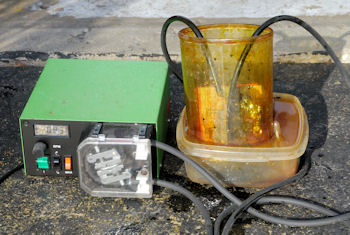Now that I have my circuit design printed out and transferred to the copper clad board, it is time to etch away the exposed copper. My previous approach to etching circuit boards at home consisted of a submerging the board in a tank with an aquarium pump bubbling ambient oxygen. The oxygen is used in the chemical reaction that removes the unprotected copper.
I noticed that removing the board for inspection during etching appeared to speed the process. This is due to both exposing the board to more oxygen and removing loose particles and film by agitation. I wondered whether I could use less etchant and speed the process by pumping etchant over an exposed board, as opposed to submerging the board.
Etchant chemicals break down metals. That’s their purpose. Unfortunately, the chemicals will harm any metal parts of a pump that come in contact with the liquid.
Fortunately, there is a type of pump, called a peristaltic pump or roller pump, which makes no contact with the fluid. These types of pumps are common medical devices for moving blood, or for other purposes where contaminants would be harmful to the fluid (or vice versa).
A peristaltic pump clamps down on a flexible hose and pushes the fluid, usually by rotating rollers.

Close-up of a peristaltic pump with Santoprene tubing.
I got the peristaltic pump from eBay. From McMaster-Carr, I purchased Santoprene tubing (#51225K27) as it soft and flexible, and ferric chloride has little or no effect on it.
My plan was to machine a spray nozzle or drip attachment. However, due to excitement, I couldn’t wait to try etching the color PCBs. So, I simply aimed the tube at the top of the boards.


Pumping ferric chloride etchant over copper clad boards.
Here’s what the circuit board looks like, part way through etching:

Partly etched PCB.
Not surprisingly, the copper with the greatest volume of etchant flowing across it is removed first. This means that I need to move the hose back and forth or develop a spray attachment to more evenly distribute the fluid.
There seems to be a phenomenon where the copper immediately below a covered trace etches more quickly than the copper above the trace. I’m not sure why. Perhaps the surface tension of the trace causes etchant to bead up and stay in contact longer to perform chemical changes.
I was unable to determine whether etching completed faster by pumping, as opposed to submersion, because my aquarium heating element shattered. Chemical reactions occur faster at higher temperatures. I etched outside on a moderately cool day without a heater. So, I can’t compare it to etching at room temperature with a heater.
Let’s take a close look at the results.